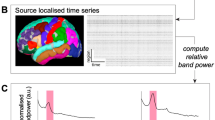Summary
In recent years, as a result of increasing calculation power of computers and with the aid of appropriate computer programs it has been made possible to calculate equivalent dipoles as intracranial representations of cerebral electrical activity. The present study investigated the localization of intracerebral equivalent dipoles in healthy controls and psychiatric patients. The equivalent dipole sources were calculated for conventional frequency bands of the background EEG. This was performed using the FFT approximation by Lehmann and Michel. Results showed more anterior equivalent sources for alpha and beta activity in all patients compared to controls. The beta activity was also generated in deeper brain structures in controls compared to patients. These results indicate that frequency bands may be generated in different brain structures in patients suffering from psychiatric diseases as compared to healthy controls and that the calculation of equivalent dipole sources may be a way to perform a sensible and substantial data reduction.
Similar content being viewed by others
References
Berger, H. On the electroencephalogram of man. Arch. Psychiatr. Nervenkr., 1929, 87: 527–570.
DeLucchi, M.R., Garoutte, B. and Aird, R.B. The scalp as an electroencephalographic averger. Electroenceph. clin. Neurophysiol., 1962, 14: 191–196.
Fritze, J., Mueller, T., Pfüller, H., Lanczik, M. and Riederer, P. Cholinergic-adrenergic balance: part 2. Relationship between drug sensitivity and personality. Psychiatry Res., 1990, 34: 271–279.
Garoutte, B. and Aird, R.B. Studies on the cortical pacemaker: synchrony and asynchrony of bilaterally recorded alpha and beta activity. Electroenceph. clin. Neurophysiol., 1958, 10: 259–268.
Gutowitz, H., Zemon, V. and Knight, B.W. Source geometry and dynamics of the visual evoked potential. Electroenceph. clin. Neurophysiol., 1986, 64: 308–327.
Jakob, H. and Beckmann, H. Prenatal disturbances in the limbic allocortex in schizophrenics. J. Neural. Transm., 1986, 65: 303.
Kavanagh, R.N., Darcey, T.M., Lehmann, D. and Fender, D.H. Evaluation of methods for three-dimensional localization of electrical sources in the human brain. IEEE Trans Biomed. Eng., 1978, 25: 421–429.
Kim, J.S., Kornhuber, H.H., Schmid-Burgk, W. and Holzmüller, B. Low cerebral fluid glutamate in schizophrenic patients and a new hypothesis on schizophrenia. Neuroscience Letters, 1980, 20: 379–382.
Lehmann, D. and Michel, C.M. Intracerebral dipole sources of EEG FFT power maps. Brain Topography 1989, 2: 155–169.
Lehmann, D. and Michel, C.M. Intracerebral dipole source localization for FFT power maps. Electroenceph. clin. Neurophysiol., 1990, 76: 271–276.
Lehmann, D., Ozaki, H. and Pal, I. Averaging of spectral power and phase via vector diagram best fits without reference electrode or reference channel. Electroenceph. clin. Neurophysiol., 1986, 64: 350–363.
Norcia, A.M., Sutter, E.E. and Tyler, C.W. Electrophysiological evidence for the existence of coarse and fine disparity mechanism in human. Vision Res.,1985, 25: 1603–1611
Petsche, H. Wie ensteht das EEG. EEG-Labor, 1989, 11: 120–135.
Scherg, M. and von Cramon, D. A new interpretation of the generators of BAEP waves I-V: results of a spatio-temporal dipole model. Electroenceph. clin. Neurophysiol., 1985, 62: 290–299.
Tandon, R., Shipley, J.E., Greden, J.F., Mann, N.A., Eisner, W.H. and Goodson, J. Muscarinic hyperactivity in schizophrenia. Schizophrenia Res., 1991, 4: 21–30.
Winer, B.J. Statistical principles in experimental design. McGraw, New York, 1971.
Author information
Authors and Affiliations
Additional information
Acknowledgements: The software for calculation of FFT approximation was kindly made available by Prof. Lehmann and Dr. Michel at the University of Zurich. The author thanks Dr. L. Frölich for helpful discussion and Ms. Groebner and Ms. Gahn for their skillful technical assistance.
Rights and permissions
About this article
Cite this article
Dierks, T. Equivalent EEG sources determined by FFT approximation in healthy subjects, schizophrenic and depressive patients. Brain Topogr 4, 207–213 (1992). https://doi.org/10.1007/BF01131152
Accepted:
Issue Date:
DOI: https://doi.org/10.1007/BF01131152




